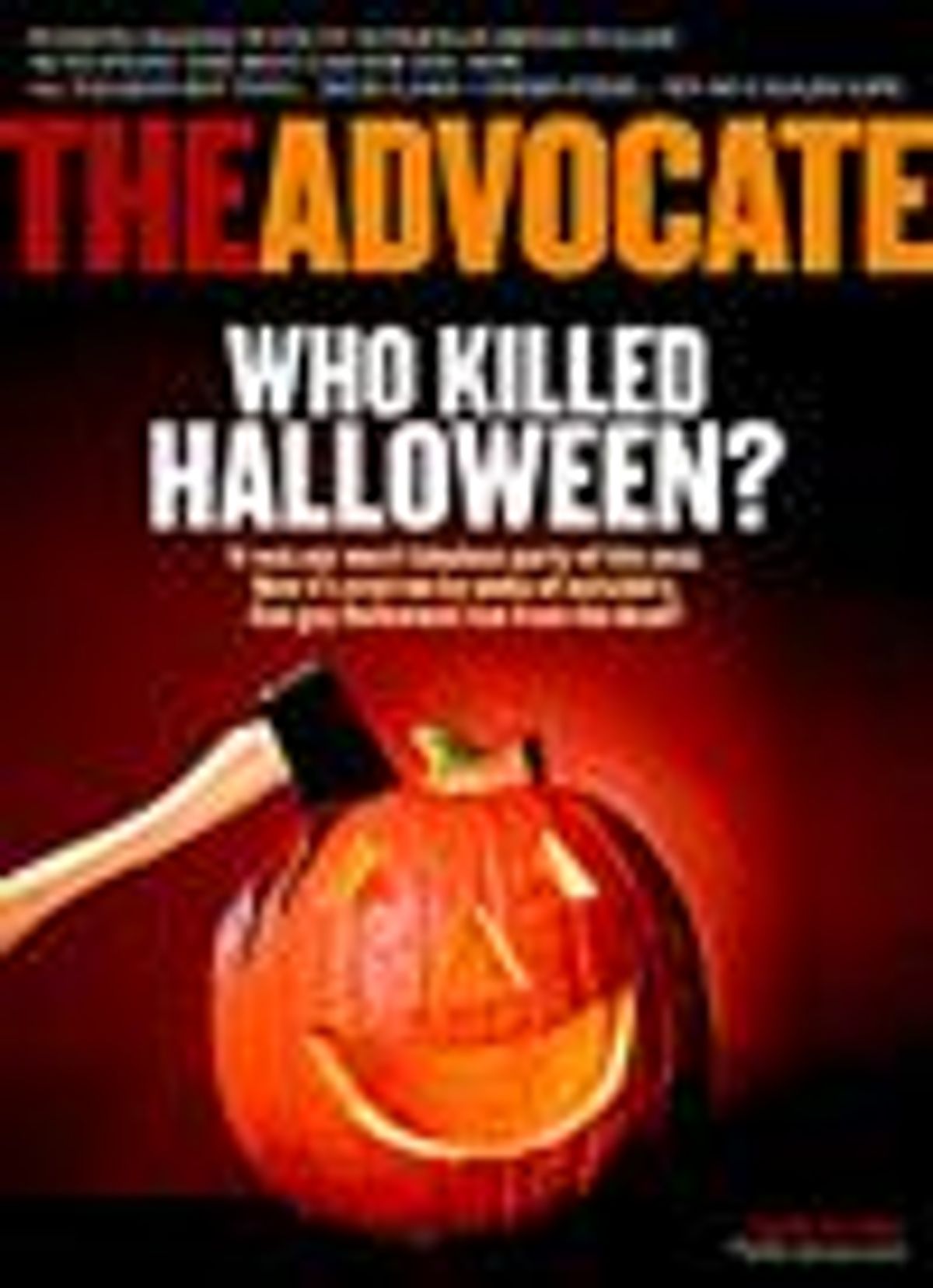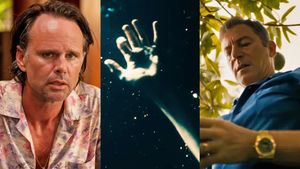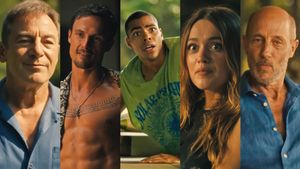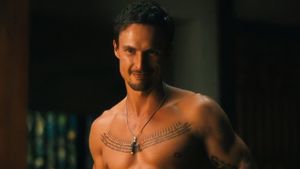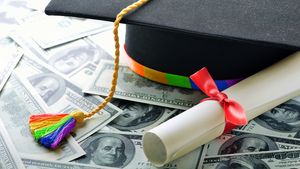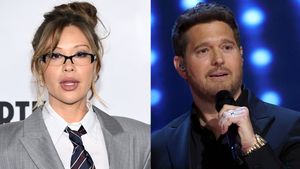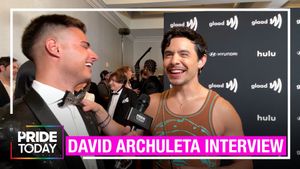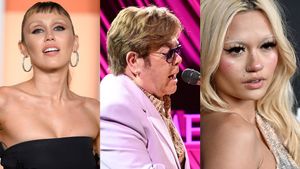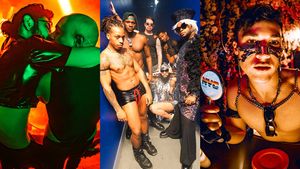"i
remember the year i noticed the shift," says Jeanne
Fleming, a longtime organizer of New York
City's Village Halloween Parade. The year was
1989. Downtown Manhattan was a gritty, crime-ridden outpost
of artists, homos, junkies, and freaks. So perhaps
it's fitting that Fleming's epiphany
came in the form of passing garbage trucks.
"We had
sanitation trucks as part of the parade," she
recalls. "They were mirrored on all sides -- an
artist would cover them with Mylar, and seven of them
would drive through and do this fantastic choreographed
routine." Watching the trucks go by and getting
a good look at the crowds reflected in the
trucks' sides, Fleming suddenly realized: Oh, my
God, I'm running a straight event.
How did that happen?
She wasn't
alone. Across the country Halloween festival organizers were
coming to the same realization: Their local gayborhood
parties were attracting an annual pilgrimage of
heterosexuals -- college kids in pea coats, suburban
Republicans, teens from the rough side of town. They
arrived, costume-free, to get drunk, climb lampposts, whoop
and gawk, take pictures, and, occasionally, harass.
Granted,
it's a show worth watching. Halloween street parties
have always been the perfect excuse for gays to
showcase their creativity in an atmosphere free of
judgment and scorn. "There were lots of very
imaginative gay people who would come in wonderful things,
like dressed as Imelda Marcos's shoes,"
says Ralph Lee, who is credited with starting the
Village Parade in 1974. "One year there were these
four guys dressed as stewardesses, with little
carry-ons, each with a letter on it, and when they
lined up it spelled T-W-A-T." Costumes often tend to
be topical too, reflecting the zeitgeist. The year
1979 saw an army of Eva Perons -- Evita had hit
Broadway that year -- the more creative ones sporting
a bank of microphones ingeniously designed into the dress to
mimic Peron on her balcony.
In such a festive
atmosphere, is it any wonder that Halloween became a
gay national holiday -- it's "gay
Christmas." And through most of the '80s
at least, before such events became formally organized and
publicized, these parties were ours, a place where we could
let our hair down and get crazy with our peers. It was
our secret -- until word got out, and the mainstream
decided to crash the party.
While the crowds
of straight spectators at Halloween carnivals have been
growing for years, 2006 may have been a tipping point. Last
year, according to organizers, the festivities in New
York and Washington, D.C., drew their largest crowds
ever, with the parade in the Village stretching for a
full hour longer than the previous year's. The West
Hollywood Halloween Carnaval on Santa Monica Boulevard,
which today draws half a million, was "like a
mosh pit for a mile and a half," says Jeff
Scott, a longtime attendee. For the first time in 18 years,
he says, he went home early.
The media that
dominate today's events only add to the chaos. New
York's event is covered by 38 international
television crews, says Fleming, who in late September
had just fielded a photo request from Time Out Beijing.
As far back as
1998, a gay council member representing the Village asked
the city to cancel or move the event, citing "a sea
of homophobia." A gay community board member
summed up his feelings as a parade participant:
"Many of these people who come out now are not there
to laugh with us. They are there to laugh at
us," he told The New York Times.
Because the
parties aren't the domain of straight attendees, they
don't have a stake in their sustainability.
"The gay people, you tell them to get behind
the line, and they will," says David Perruzza,
organizer of Washington, D.C.'s Halloween High
Heel Race. "The straight people, you tell them
500 times, and they keep pushing forward."
It's not
just ridicule and unruliness that threaten the events,
though -- it's violence. Last year in San
Francisco, where the party in the Castro has recently
been bursting at the seams, gunfire exchanged between two
gangs with automatic weapons left 10 people wounded,
prompting the city to call off this year's
event. For the first time in three decades, there will
be no official Halloween party in the Castro.
Bevan Dufty, city
supervisor for the Castro district and the person who,
with the mayor, spearheaded the movement to cancel the
party, says, "Halloween is the most miserable
issue I've worked on in my years as a public
official." It could be argued they waited too long to
cancel: The year Dufty was elected, in 2002, five
people at the event were stabbed, and another person
brought along a working chain saw as part of his
costume. "It was like Escape From New
York," Dufty says.
Though many
attempts were made to bring the San Francisco event under
control, things have just gotten more dangerous. Dufty
claims that the party in the Castro has become
"a rite of passage for young gang members"
to attend and spark violence. Furthermore, he says,
"all my neighborhood groups in the greater
Castro area are just disgusted with it."
The day after the
2006 shootings the San Francisco Chronicle's
online comments section was blanketed with calls to move or
cancel future events. "The shootings occurred a
mere two blocks from where I live," read one
typical post. "After they shut down the party, it
continued for hours afterward on my street, which was
clogged with people not from the neighborhood but
tourists from other parts of the city and the East
Bay.... Cancel it."
But canceling gay
Christmas, in the gayest neighborhood in the gayest
city in America, is like canceling New Year's Eve in
Times Square -- which is to say, Won't people
show up anyway? That's the question that now
has San Francisco holding its breath. "I have lived
in the Castro for 13 years," says Donna Sachet,
a drag artiste whose bewigged and bejeweled visage was
the public face of the celebration on fliers, billboards,
and bus ads from 2003 to 2005. "There are
certain organic things that happen. The pride
celebration -- it may be held at the Civic Center, but after
it's over, everyone comes back to the Castro. New
Year's Eve? Back to the Castro."
Most of these
Halloween parties began as a trickle in the '70s and
'80s, back when gay ghettoization felt
practical. D.C.'s High Heel Race was founded by
accident 21 years ago when a few guys in drag ran from
JR's, a gay bar on 17th Street, to
Annie's Steak House a few blocks away, did a
shot, and ran back. (The race's present route is the
same; JR's is the unofficial sponsor.) In San
Francisco the party moved to the Castro in the
'70s when the queer Halloween celebration on Polk
Street began to attract straight people and turned
violent.
And the Village
Parade didn't even start out as gay. Artist Ralph Lee
led "a motley group of a hundred friends and
performers" through the streets in 1974. They
had an escort of two police scooters and a grant of $200
from the city. It took a few years for gay people to attach
themselves to that event, which was already sort of
queer in that it was "the only parade that went
crosstown" instead of downtown like other parades,
says Lee, laughing.
By the late
'80s all of these events were being forced to
accommodate growing crowds. West Hollywood closed down
one side of Santa Monica Boulevard, then the other.
The Village Parade was "straightened out" and
pointed down Sixth Avenue. Police and Porta Pottis were
deployed. The parties continue to grow in size every
year, with straights outnumbering gays by an
ever-larger ratio.
This gay-straight
imbalance, however, could be seen as a product of our
own achievements. Call it a sign of progress that
"it's the straight girls who all want to
get their pictures taken with the drag queens,"
says Perruzza. "They're here for college from
a small Midwestern town, and they've never seen
anything like this."
Puppeteer Basil
Twist, a well-known fixture of the Village Parade since
the late '80s -- who found mainstream success himself
by designing the Dementors in the Harry Potter movies
-- thinks that for straight people, the gay dimension
to these events has become more than "just
entertainment. They're living vicariously through us
because of the freedom we have, that freedom that
everybody's capable of, but poor straight
people, they can't always hit that mark."
And as Sachet
points out, it is a symbiotic relationship: "Every
drag queen needs an audience." But what happens
when the audience begins to overtake the show?
"There's a certain healthy aspect to an
audience," says Sachet. "It's
when it becomes a freak show that it gets scary."
Though the public
is generally more enlightened about sexuality than it
was in 1998, antigay hate-crime rates have actually risen
slightly since then. And the two major incidents of
violence at the San Francisco carnival both occurred
in the past five years.
Still, most of
these events remain remarkably incident-free for their
sizes. San Francisco's problems are the exception,
not the rule, and might be blamed on the
party's confinement to a relatively small area.
Fleming attributes the lack of violence at the
Village's event--which routinely draws
well over a million people -- to the parade format, which
keeps things spread out and moving forward. Keeping the
Castro event enclosed is like "strangling a
snake," says Sachet. "Last year Bevan made
the announcement that we're going to close it down
earlier, make it smaller, when what they need to do is
manage it and make room for it. By trying to close it
down, you're just confining people to a smaller
space." Indeed, last year's shooting occurred
at 10:40 p.m., 10 minutes after police cut the music
and tried to shut down the party.
Which brings us
to another bittersweet fact about the evolution of our
movement. We're losing our separateness. That some of
the loudest voices calling for the parties'
cancellations are coming from gay people says
something: It's not only straight people moving in
that's changing the feel of the events,
it's gay people dropping out. These days, the gay
ghettos where the parties are held are home to increasingly
older residents. Younger gays are fanning out across
the city, unafraid of living in mostly straight
neighborhoods. "It's certainly an aging
population" in the Castro, says Sachet.
"Same-sex couples are adopting children and
settling into their homes." They don't want
people "shitting in their
flowerpots"--a vivid image often invoked by the
NIMBY crowd.
At the same time,
straight families are moving into the gay
neighborhoods--one need only look around the Castro,
West Hollywood, the Village, and Dupont Circle in D.C.
to see the upstart image of Bugaboo strollers
propelled by straight couples everywhere. And gay people no
longer feel confined to urban areas. Census data suggests
that the number of same-sex couples in San Francisco
declined by 5% between 2000 and 2005, more than twice
the rate of decline in straight couples.
Which raises the
question, Is there even a need for a "gay
Christmas" anymore? Thirty years ago, adopting
Halloween as a gay holiday felt necessary. "It
was a chance to throw away, like RuPaul says, your
'other drag,' " says
Twist. "I think that's less true now. We have
our gay pride events, we have gay day at [Six Flags]
Great America. There are lots of opportunities for gay
people to be sure on Halloween to be that one day."
In past decades
many of us weren't invited to the traditional family
Christmas. Today, we raise our own families and,
increasingly, celebrate the holidays with Mom and Pop.
Maybe today, gay Christmas simply falls on December
25.
Twenty years ago,
when the High Heel Race was a scant two years old,
another event -- for gays only, by invitation only -- was
already being formed. The Miss Adams Morgan Pageant, a
private Halloween party for D.C.'s gay elite,
is a notoriously private event; it banishes the media
and fosters an air of mystery. Tickets are available only to
those with connections. It's held annually in
the Hilton Washington ballroom in the weeks preceding
Halloween. Aside from the by-invite-only exclusivity, it
essentially tries to capture the spirit of the old days,
when Halloween events were smaller, gayer affairs,
with familiar ladies' heavily painted faces all
around.
Predictably, a
spokesman for the pageant declined to comment for this
story, but one four-time attendee describes it as "a
sit-down dinner" with "not one person
out of thousands of people who's not in some kind of
drag." He recalls walking into the ballroom by way of
the hotel lobby in full female regalia, passing groups
of slack-jawed tourists. "There are all these
stunned onlookers who watch you walk through," he
says -- straight gawkers who get only a glimpse of the
festivities before the ballroom doors are shut tight,
keeping out straights, troublemakers, and other
undesirable elements.
For those of us
not on the guest list, the festivities on the streets
carry on with a sense of inevitability -- bigger, crazier,
straighter every year.
"What
I've noticed about the parade," says Fleming,
"is it reflects what's going on in the
city." New York, like most other big urban areas,
has become less of an enclave for eccentrics and outcasts in
recent years. Fleming says there were so many
strollers at last year's parade that the police
asked her how she'd feel about giving them their own
separate viewing section. "And I think the gay
community changed," she says. "Folks got
older. And the issues changed. There's a big
difference between fighting to be able to come out and
be seen, and fighting for health benefits."
"But I see
the parade as being about unconditional love," she
continues. "So when I hear people say,
'Oh, it's been taken away from us,'
I'm like, wait a minute. Nobody's taking
anything away from you. Come to the parade. Come join
your family."
As for the
Castro, Dufty says the city has an extensive public safety
plan in place should crowds show up despite the official
cancellation. He says he's persuaded a number
of the bars and restaurants to close for the night and
that there will be a large police presence. "There
will be zero tolerance for any infraction of the
law," he says. "We're going to take a
hard line with illegal activity early in the
evening."
But it's
hard to imagine that the party won't happen,
regardless of what the city says. Perhaps a good
barometer is Sachet, the carnival's best-known
attendee. Asked if she'll be partying in the usual
place despite the ban, she pauses a moment before
confessing, "I live and I work and I love in
this community. I'll be celebrating Halloween in the
Castro."
